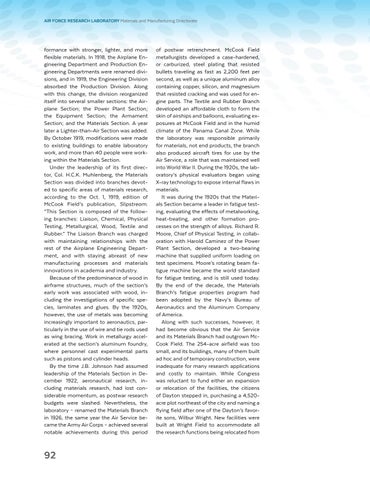AIR FORCE RESEARCH LABORATORY Materials and Manufacturing Directorate
formance with stronger, lighter, and more flexible materials. In 1918, the Airplane Engineering Department and Production Engineering Departments were renamed divisions, and in 1919, the Engineering Division absorbed the Production Division. Along with this change, the division reorganized itself into several smaller sections: the Airplane Section; the Power Plant Section; the Equipment Section; the Armament Section; and the Materials Section. A year later a Lighter-than-Air Section was added. By October 1919, modifications were made to existing buildings to enable laboratory work, and more than 40 people were working within the Materials Section. Under the leadership of its first director, Col. H.C.K. Muhlenberg, the Materials Section was divided into branches devoted to specific areas of materials research, according to the Oct. 1, 1919, edition of McCook Field’s publication, Slipstream. “This Section is composed of the following branches: Liaison, Chemical, Physical Testing, Metallurgical, Wood, Textile and Rubber.” The Liaison Branch was charged with maintaining relationships with the rest of the Airplane Engineering Department, and with staying abreast of new manufacturing processes and materials innovations in academia and industry. Because of the predominance of wood in airframe structures, much of the section’s early work was associated with wood, including the investigations of specific species, laminates and glues. By the 1920s, however, the use of metals was becoming increasingly important to aeronautics, particularly in the use of wire and tie rods used as wing bracing. Work in metallurgy accelerated at the section’s aluminum foundry, where personnel cast experimental parts such as pistons and cylinder heads. By the time J.B. Johnson had assumed leadership of the Materials Section in December 1922, aeronautical research, including materials research, had lost considerable momentum, as postwar research budgets were slashed. Nevertheless, the laboratory – renamed the Materials Branch in 1926, the same year the Air Service became the Army Air Corps – achieved several notable achievements during this period
92
of postwar retrenchment. McCook Field metallurgists developed a case-hardened, or carburized, steel plating that resisted bullets traveling as fast as 2,200 feet per second, as well as a unique aluminum alloy containing copper, silicon, and magnesium that resisted cracking and was used for engine parts. The Textile and Rubber Branch developed an affordable cloth to form the skin of airships and balloons, evaluating exposures at McCook Field and in the humid climate of the Panama Canal Zone. While the laboratory was responsible primarily for materials, not end products, the branch also produced aircraft tires for use by the Air Service, a role that was maintained well into World War II. During the 1920s, the laboratory’s physical evaluators began using X-ray technology to expose internal flaws in materials. It was during the 1920s that the Materials Section became a leader in fatigue testing, evaluating the effects of metalworking, heat-treating, and other formation processes on the strength of alloys. Richard R. Moore, Chief of Physical Testing, in collaboration with Harold Caminez of the Power Plant Section, developed a two-bearing machine that supplied uniform loading on test specimens. Moore’s rotating beam fatigue machine became the world standard for fatigue testing, and is still used today. By the end of the decade, the Materials Branch’s fatigue properties program had been adopted by the Navy’s Bureau of Aeronautics and the Aluminum Company of America. Along with such successes, however, it had become obvious that the Air Service and its Materials Branch had outgrown McCook Field. The 254-acre airfield was too small, and its buildings, many of them built ad hoc and of temporary construction, were inadequate for many research applications and costly to maintain. While Congress was reluctant to fund either an expansion or relocation of the facilities, the citizens of Dayton stepped in, purchasing a 4,520acre plot northeast of the city and naming a flying field after one of the Dayton’s favorite sons, Wilbur Wright. New facilities were built at Wright Field to accommodate all the research functions being relocated from
